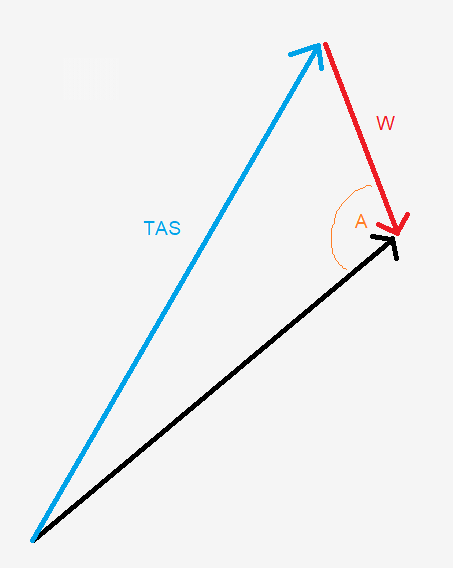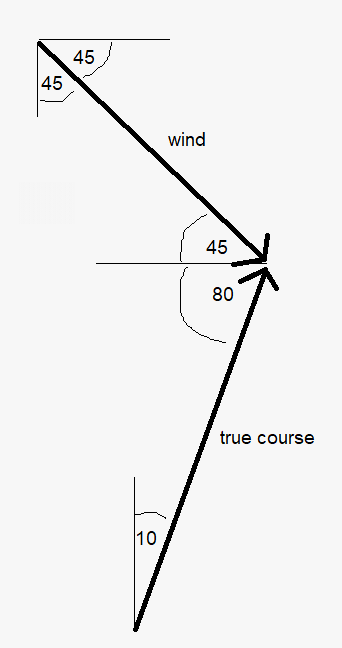RingLaserGyroSandwich
Pre-takeoff checklist
If you have a CX-2 flight computer (or equivalent), you likely plug in the true course, true air speed, wind direction, and wind speed, without giving it much thought. The computer spits out the required true heading in order for the plane to follow the proper true course, and also tells you what ground speed to expect. How does the computer do this? An E-6B does some cool mechanical rotation of vectors which I don't use and won't analyze, but I'll show the math behind the direct calculation method. If you don't like how I explain it but are interested there are other explanations floating around the internet. I'll start with a diagram to illustrate the problem.

The length of each arrow is the "magnitude" of the velocity it represents.
The red arrow represents the magnitude and direction of the wind, which is known (based on forecasts). The black arrow represents the magnitude and direction of the actual course of the plane, assuming proper wind corrections are made. We know the direction (based on drawing a line on a chart connecting our departure airport and our destination airport) but do not know the magnitude, since we don't yet know what ground speed to expect. The blue arrow represents the magnitude and direction of the plane's velocity relative to the air. The direction of the arrow is the heading of the plane after correcting for wind, and the magnitude is the true air speed which is known based on performance calculations. In short, the plane's velocity relative to the air, plus the air's velocity relative to the ground, gives the plane's velocity relative to the ground.
We know two sides of this triangle (it is not a right triangle so we can't use sin/cos/tan or the Pythagorean theorem!), TAS and W. We want to know the third side, GS (ground speed), but need to determine an angle before we can calculate it. Since we know what direction the wind is blowing, and we know the desired course, we can easily determine the angle between W and GS, which I labeled A.
In order to solve for GS, the length of the black arrow, we can use a math rule that most people forget about and never use again. The law of cosines is the more advanced version of the Pythagorean theorem and works even for non-right triangles. a^2 = b^2 + c^2 - 2 b c cos(A). In the formula, a, b, and c, are sides of the triangle, and A is the angle opposite side a. In the case of the wind triangle, A is opposite TAS, so TAS serves the role of "a". We'll say W serves the role of b (although it could be c too... they are interchangeable). Substituting:
TAS^2 = W^2 + GS^2 - 2 W GS cos(A)
That is an equation where we know the value of everything except for GS. Let's create a real example and try it out:
You want to fly direct from Ring City Airport to Laser Gyro Airport, which requires a course of 010 degrees (we'll keep directions true vice magnetic for simplicity). Your V-Tail Skychicken will achieve a TAS of 100 kts. Wind is from 315 at 20 kts. What is your required true heading and resulting ground speed to fly this course?
Just visualizing the problem, the plane will need to aim left of the destination in order to compensate for the quartering headwind (this matches the drawing, fortunately). I need to compute angle A before we can use the formula above.

By drawing the wind and the TC, then filling in all the angles (remember the angles inside triangles add up to 180 degrees), you can see that angle A is 45 + 80 = 125 degrees. Now we can solve the Law of Cosines:
100^2 = 20^2 + GS^2 - 2 20 GS cos(125 degrees)
This is a quadratic equation, which can be solved using the quadratic formula. See, all that crap from high school is useful when you decide to solve the wind triangle for fun. Rearranging the equation to make it simplest to solve:
GS^2 - [40 cos(125 degrees)] GS + (20^2 - 100^2) = 0
Further simplifying:
GS^2 + 22.943 GS - 9600 = 0
The quadratic formula says for f(x) = a x^2 + b x + c, the solution is x = -b/(2a) +/- sqrt(b^2-4ac)/(2a). In this case, a is 1 making the equation easier to use. Plugging in:
GS = -11.4715 +/- (1/2) sqrt(526.3812 + 38400) = -11.4715 +/- 98.6488. We can reject the negative solution, so GS = 87.177 kts. If you plug this problem into a CX-2 flight computer, it says your GS will be 87.2 knots. Pretty darn close.
It also says to expect a true heading of 0.6 degrees. How can we determine that without using the flight computer? Look back at the first figure. Now that we know GS, it is relatively easy to compute the angle between GS and TAS. That angle will be how far left of the destination we should aim the plane, aka, the wind correction angle (WCA). We will use the Law of Cosines again, except this time the angle will be B, the angle opposite W (remember, W was considered side b in the Law of Cosines before). The TAS and GS will be "a" and "c" respectively.
b^2 = a^2 + c^2 - 2 a c cos (B)
Notice how you can put b on the left side so long as the angle in the cosine is B. That's the neat thing about the Law of Cosines. Substituting:
W^2 = TAS^2 + GS^2 - 2 TAS GS cos(WCA)
2 TAS GS cos(WCA) = TAS^2 + GS^2 - W^2
cos(WCA) = (TAS^2 + GS^2 - W^2)/(2 TAS GS)
We need to substitute in the values for the right hand side of that equation, then take the inverse cosine (aka arc cosine) to find the WCA. By my calculations, the right hand side of that equation is 17,199.829/17,435.4 = 0.986. The arc cosine of 0.986 is 9.599 degrees. Correcting left from the course of 010 by a WCA of 9.599 degrees gives a true heading of 0.4 degrees. Oops, I was off by a two tenths of a degree. Actually, that's pretty close! The CX-2 is actually a little more accurate than I was because it uses somewhat more sophisticated mathematical methods to perform the calculations, but the concept is exactly the same in either case.
Once you turn the procedure above into an algorithm, a simple flight computer can calculate the ground speed and WCA in a short fraction of a second. Or, you can play around with the mechanical E-6B if you enjoy it and like battery independence. Or... you can just let ForeFlight do it all for you.

The length of each arrow is the "magnitude" of the velocity it represents.
The red arrow represents the magnitude and direction of the wind, which is known (based on forecasts). The black arrow represents the magnitude and direction of the actual course of the plane, assuming proper wind corrections are made. We know the direction (based on drawing a line on a chart connecting our departure airport and our destination airport) but do not know the magnitude, since we don't yet know what ground speed to expect. The blue arrow represents the magnitude and direction of the plane's velocity relative to the air. The direction of the arrow is the heading of the plane after correcting for wind, and the magnitude is the true air speed which is known based on performance calculations. In short, the plane's velocity relative to the air, plus the air's velocity relative to the ground, gives the plane's velocity relative to the ground.
We know two sides of this triangle (it is not a right triangle so we can't use sin/cos/tan or the Pythagorean theorem!), TAS and W. We want to know the third side, GS (ground speed), but need to determine an angle before we can calculate it. Since we know what direction the wind is blowing, and we know the desired course, we can easily determine the angle between W and GS, which I labeled A.
In order to solve for GS, the length of the black arrow, we can use a math rule that most people forget about and never use again. The law of cosines is the more advanced version of the Pythagorean theorem and works even for non-right triangles. a^2 = b^2 + c^2 - 2 b c cos(A). In the formula, a, b, and c, are sides of the triangle, and A is the angle opposite side a. In the case of the wind triangle, A is opposite TAS, so TAS serves the role of "a". We'll say W serves the role of b (although it could be c too... they are interchangeable). Substituting:
TAS^2 = W^2 + GS^2 - 2 W GS cos(A)
That is an equation where we know the value of everything except for GS. Let's create a real example and try it out:
You want to fly direct from Ring City Airport to Laser Gyro Airport, which requires a course of 010 degrees (we'll keep directions true vice magnetic for simplicity). Your V-Tail Skychicken will achieve a TAS of 100 kts. Wind is from 315 at 20 kts. What is your required true heading and resulting ground speed to fly this course?
Just visualizing the problem, the plane will need to aim left of the destination in order to compensate for the quartering headwind (this matches the drawing, fortunately). I need to compute angle A before we can use the formula above.

By drawing the wind and the TC, then filling in all the angles (remember the angles inside triangles add up to 180 degrees), you can see that angle A is 45 + 80 = 125 degrees. Now we can solve the Law of Cosines:
100^2 = 20^2 + GS^2 - 2 20 GS cos(125 degrees)
This is a quadratic equation, which can be solved using the quadratic formula. See, all that crap from high school is useful when you decide to solve the wind triangle for fun. Rearranging the equation to make it simplest to solve:
GS^2 - [40 cos(125 degrees)] GS + (20^2 - 100^2) = 0
Further simplifying:
GS^2 + 22.943 GS - 9600 = 0
The quadratic formula says for f(x) = a x^2 + b x + c, the solution is x = -b/(2a) +/- sqrt(b^2-4ac)/(2a). In this case, a is 1 making the equation easier to use. Plugging in:
GS = -11.4715 +/- (1/2) sqrt(526.3812 + 38400) = -11.4715 +/- 98.6488. We can reject the negative solution, so GS = 87.177 kts. If you plug this problem into a CX-2 flight computer, it says your GS will be 87.2 knots. Pretty darn close.
It also says to expect a true heading of 0.6 degrees. How can we determine that without using the flight computer? Look back at the first figure. Now that we know GS, it is relatively easy to compute the angle between GS and TAS. That angle will be how far left of the destination we should aim the plane, aka, the wind correction angle (WCA). We will use the Law of Cosines again, except this time the angle will be B, the angle opposite W (remember, W was considered side b in the Law of Cosines before). The TAS and GS will be "a" and "c" respectively.
b^2 = a^2 + c^2 - 2 a c cos (B)
Notice how you can put b on the left side so long as the angle in the cosine is B. That's the neat thing about the Law of Cosines. Substituting:
W^2 = TAS^2 + GS^2 - 2 TAS GS cos(WCA)
2 TAS GS cos(WCA) = TAS^2 + GS^2 - W^2
cos(WCA) = (TAS^2 + GS^2 - W^2)/(2 TAS GS)
We need to substitute in the values for the right hand side of that equation, then take the inverse cosine (aka arc cosine) to find the WCA. By my calculations, the right hand side of that equation is 17,199.829/17,435.4 = 0.986. The arc cosine of 0.986 is 9.599 degrees. Correcting left from the course of 010 by a WCA of 9.599 degrees gives a true heading of 0.4 degrees. Oops, I was off by a two tenths of a degree. Actually, that's pretty close! The CX-2 is actually a little more accurate than I was because it uses somewhat more sophisticated mathematical methods to perform the calculations, but the concept is exactly the same in either case.
Once you turn the procedure above into an algorithm, a simple flight computer can calculate the ground speed and WCA in a short fraction of a second. Or, you can play around with the mechanical E-6B if you enjoy it and like battery independence. Or... you can just let ForeFlight do it all for you.


